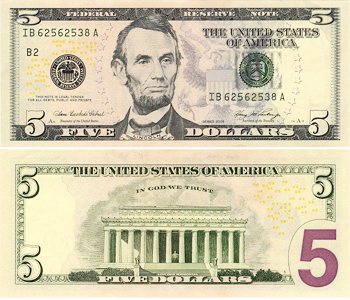 By Dr. Sol Taylor
By Dr. Sol Taylor
"Making Cents"
Saturday, August 16, 2008
| T |
Watermarks cannot be copied on copiers. That was one proposed change. Another was the hologram: a colored image that changes color depending on the viewing angle. Microprinting also was considered, as very tiny images did not copy well, even on the finest copiers of the time. Finally, adding subtle colors to the notes would make the duplication more difficult.
By the late 1990s, the BEP was ready to implement its four step approach to deter counterfeiters.
The first colorized $20 bills came out in 2003. They incorporated these measures, which assured a much lower rate of bogus money. However, new counterfeit $20s showed up in the marketplace and overseas, where the public was not alert to the new notes and the old notes were still in common use.
The FBI and Secret Service indicated that since 2003, the volume of bad paper money has declined, but it is still a problem.
In short order, the new $100s, $50s and $10 were revamped with these security features. Other cosmetic changes such as enlarging the portraits and changing the serial numbering system were not specifically aimed as anti-counterfeiting. The older series of notes were withdrawn as soon as they wound up in banks or post offices and government agencies.
The latest changed note is the $5 bill, which also features a large "5" on the back — mostly as an aid to the visually impaired. Thus far, notes do not have Braille or bar codes to enable the blind to read the notes or for scanners to "read" the notes. These features are being considered in future changes.
Some countries produce notes on polymers — not paper — and include a clear portion which cannot be produced on paper. Mexico, Israel, Bulgaria and Australia are a few of the countries that have issued such "plastic" notes. A special value of such notes is that they do not work well on standard copiers but must be made by the more labor-intensive intaglio process.
The current $1 and $2 bills do not have any plans for colorization or the addition of such anti-counterfeiting features. Counterfeiters have not produced fake $1 notes in many decades, and there is no record of counterfeit $2 bills. However, the $2 bill has been used by some artisans in the past with the old oval portraits, to alter them to appear to be $20 bills. Such alterations have not been seen since the $20 became colorized.
Since the first changes were instituted less than a decade ago, several more changes have been made to keep updating the technology and stay ahead of the finest copiers available. A new-styled $100 is planned in the near future, as many of the first-generation colorized $100s have been counterfeited in quantity.
Staying ahead of the fakers has been a full-time research and development activity of the BEP, FBI and Secret Service. As a result, our currency will undergo periodic changes to keep ahead of the game and assure the public that its currency is valid and genuine.
With credit cards and electronic payments replacing much of our currency transactions of the past, the future probably will offer fewer notes than now, and more than likely a different style — smaller plastic notes, notes that resemble credit cards versus currency as we now know it, or electronic chip or discs — totally replacing paper money.
For the immediate future, we — and most other countries — will be updating our paper currency to stay ahead of the counterfeiters and keep up with the economy of the time.
©2008 SCV COMMUNICATIONS GROUP & SOL TAYLOR · ALL RIGHTS RESERVED.

![[Most Recent Quotes from www.kitco.com]](http://www.kitconet.com/images/quotes_special.gif)
